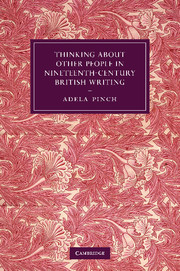Book contents
- Frontmatter
- Contents
- Acknowledgements
- Introduction: Love thinking
- 1 Thinking as action: James Frederick Ferrier's Philosophy of Consciousness
- 2 Foam, aura, or melody: theorizing mental force in Victorian Britain
- 3 Thinking in the second person in nineteenth-century poetry
- 4 Thinking and knowing in Patmore and Meredith
- 5 Daniel Deronda and the omnipotence of thought
- Conclusion: the ethics of belief and the poetics of thinking about another person
- Notes
- Bibliography
- Index
- Cambridge Cultural Social Studies
2 - Foam, aura, or melody: theorizing mental force in Victorian Britain
Published online by Cambridge University Press: 05 October 2010
- Frontmatter
- Contents
- Acknowledgements
- Introduction: Love thinking
- 1 Thinking as action: James Frederick Ferrier's Philosophy of Consciousness
- 2 Foam, aura, or melody: theorizing mental force in Victorian Britain
- 3 Thinking in the second person in nineteenth-century poetry
- 4 Thinking and knowing in Patmore and Meredith
- 5 Daniel Deronda and the omnipotence of thought
- Conclusion: the ethics of belief and the poetics of thinking about another person
- Notes
- Bibliography
- Index
- Cambridge Cultural Social Studies
Summary
In this chapter, I follow the thread of the previous chapter's investigation of nineteenth-century accounts of mental causation into the later decades of the century. The preceding chapter demonstrated that a focus on consciousness as a form of action could reveal strange philosophical bedfellows in the 1830s – a quirky but compelling idealist such as James Frederick Ferrier, and believers in mesmerism. As we move forward, the bedfellows just get stranger. A focus on strongly causal accounts of thinking reveals connections among Victorian physicists theorizing mental force in the new terms of their own discipline: a mystical woman mathematician; a weird but influential ear doctor; believers in phantasms; theosophists, Platonists, epiphenomenalists, pan psychists and positivists; and an idealist philosopher who articulated a compelling version of “love thinking”: a particular kind of cognition that produces not knowledge but ethical, mystical bonds.
The development of ideas about mental force ought to be central to any account of nineteenth-century philosophy and psychology. However, by trying to tease out of the wealth of nineteenth-century writing on the mind a strand of thinking specifically about “thinking about other people,” we are able to tell a particular story that casts a wider net, capturing writers and ideas from a broader range of fields. Like James Frederick Ferrier, the philosophical (and pseudo-philosophical) writers we meet in this chapter – such as the idiosyncratic metaphysician Shadworth Hodgson, the utopian polygamist ear doctor James Hinton, the philosophical ribbon-manufacturer Charles Bray, the psychological mathematician Mary Everest Boole, and even the fin-de-siècle idealist J. M. E. McTaggart – are by and large not mainstream figures.
- Type
- Chapter
- Information
- Publisher: Cambridge University PressPrint publication year: 2010



